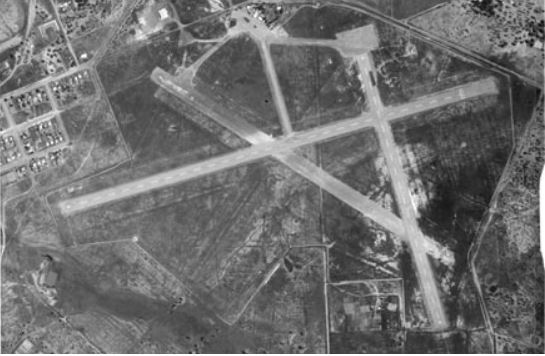Difference between revisions of "No. 4 Aircraft Depot RAAF"
From Our Contribution
(→Unit Personnel) |
(→Unit Personnel) |
||
| Line 34: | Line 34: | ||
*[[Beryl Marion Francis]] | *[[Beryl Marion Francis]] | ||
*[[Maxwell Kenneth Ottaway]] | *[[Maxwell Kenneth Ottaway]] | ||
| − | *[[Reginald Thomas Blackman]] | + | *[[Reginald Thomas Blackman]] 17 Jan - 13 Jun 1945 |
Revision as of 01:13, 22 September 2020
 Aerial view of Boulder base for No. 4 Aircraft Depot | |
Brief History
No. 4 Aircraft Depot was formed at Pearce on 15 May 1942 with a cadre of one officer and five airmen. At the end of the month it moved to its 'permanent' home, the racecourse at Boulder. Over the following months hangars, barrack blocks and other facilities were built and the adjacent airfield was taken over. By the end of 1942 the Depot was ready to start repairing and overhauling aircraft engines, airframes and ancillary aircraft equipment, mainly for units located in Western Australia. At that stage at had a strength of 17 officers and 206 airmen.
The first aircraft to be worked on were Brewster Buffalos from No. 25 Squadron at Pearce. By the end of 1942 the engine repair workshops had been completed and the first batch of Pratt and Whitney R1830, 14 cylinder twin-row radial engines had arrived for overhaul. This was to e a major task for the unit over the next three years.as they were used in US and Qantas Catalinas as well as RAAF Beaufort, Dakota and Boomerangs aircraft. The Catalina engines arrived by rail, and the RAAF engines with the aircraft. By mid 1943 the Depot staff numbered 26 officers, 664 airmen, and 24 WAAAF.
Facilities were completed late in 1943 and Depot strength increased to almost 1,000. They were now also working on CAC Boomerang and Vultee Vengeance as well as Bristol Beaufort, CAC Wirraway, North American Dakota, Lockheed Hudson, and Curtis P-40 Kittyhawk aircraft. By January the following repair sections and shops were in full production: engine, propeller, instrument, bombsight, parachute, hydraulic, armament, radio, radar, sheet metal, machine shop. copper-smith, black-smith, carpentry, fabric, welding. fitting and turning, paint shop, salt bath, electroplating and engine test bed. On the flying side there was a flight test section, air traffic control and tarmac servicing. This latter section was kept busy, not only with aircraft being tested and ferried to and from the Depot, but also aircraft transiting between Perth and eastern Australia.
Throughout 1944 work continued at a steady pace, and the unit enjoyed very high morale. Towards the end of 1944, No. 85 Squadron was re-equipped with Spitfires, and No. 25 Squadron re-equipped with B-24 Liberators. The CAC Boomerang and Vultee Vengeance aircraft replaced were ferried to No. 4 Aircraft Depot to be maintained until disposed of. After mid-1945 the workload of the Depot started to decrease, reflecting reduced operational activity in the Western Area. The US Navy Catalinas had also moved from Perth. After the Japanese surrender in mid-August, work was restricted to the repair and overhaul of currently held equipment. From then until April 1946, when the Depot closed there was a steady run down in personnel.
Unit Personnel
- Robert Alexander MacLean 23 Jan 1943 - 4 Jun 1944
- Alfred Ensor Hand 30 Oct 1944 - 3 Jan 1946
- Edward Trayton Elvish
- Dulcie May Faulkner
- Beryl Marion Francis
- Maxwell Kenneth Ottaway
- Reginald Thomas Blackman 17 Jan - 13 Jun 1945
Trainees
Notes